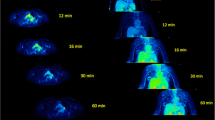Abstract.
Obtaining consistent high image quality is desirable for clinical positron emission tomography (PET). Body morphology may impact image quality. The purpose of this study was to define the average and the range of body sizes in patients undergoing tumor PET studies in our center and to determine how the body habitus affects the statistical and visual quality of PET images. Height, weight, body surface area (BSA), and body mass index (BMI) were determined in 101 male and 101 female patients (group 1) referred for clinical PET. The summed total counts from three consecutive transaxial slices on non-attenuation-corrected (NAC) 2D fluorine-18 fluorodeoxyglucose (FDG) PET images, which included the largest liver section and no lesions, were determined and compared with body morphology and injected doses (ID) in a representative group of 30 male and 30 female patients (group 2) spanning a range of body morphologies. The visual quality of images was also evaluated using a scoring system by three readers. The average height, weight, and BSA were greater in male than in female patients, but the average BMI was not different between them in group 1. The largest value of weight or BMI was more than four times the smallest value in female patients. The total true counts were best correlated with ID/weight (mCi/kg) in group 2 (r=0.929, P<0.0001). Intermediate to high total counts (930,000 or more) corresponded to ID/weight of 0.22 or higher. The average visual score was positively correlated with the total counts (ρ=0.63, P<0.0001) and with ID/weight (ρ=0.68, P<0.0001) on NAC images. The image quality in 22 (84.6%) of 26 patients with intermediate to high total counts was adequate to good, whereas that in 21 (61.8%) of 34 patients with lower total counts was suboptimal. A wide variety of body morphologies was observed in patients referred for clinical FDG-PET tumor studies in our center. The total counts and average image visual score were negatively correlated with weight. Counts in heavy patients were as low as one-fourth those in light patients. Adjusting injected FDG dose in each patient on the basis of body weight may be more appropriate to achieve consistent PET image quality than giving a fixed injected FDG dose.
Similar content being viewed by others
Author information
Authors and Affiliations
Additional information
Electronic Publication
Rights and permissions
About this article
Cite this article
Tatsumi, M., Clark, P.A., Nakamoto, Y. et al. Impact of body habitus on quantitative and qualitative image quality in whole-body FDG-PET. Eur J Nucl Med 30, 40–45 (2003). https://doi.org/10.1007/s00259-002-0980-5
Received:
Accepted:
Issue Date:
DOI: https://doi.org/10.1007/s00259-002-0980-5




